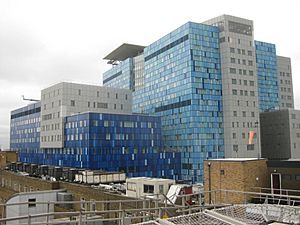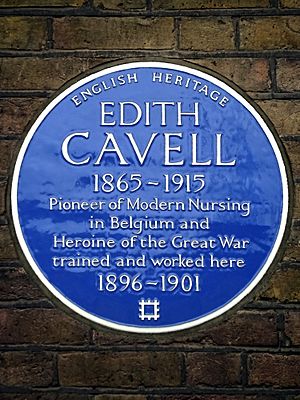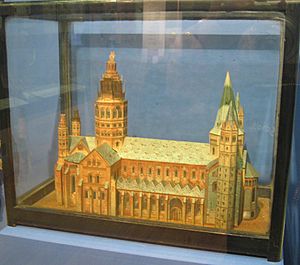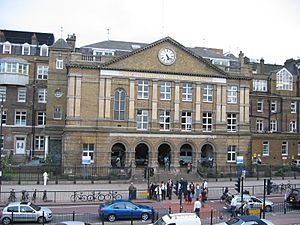Royal London Hospital facts for kids
Quick facts for kids Royal London Hospital |
|
|---|---|
| Barts Health NHS Trust | |

The current Royal London Hospital under construction in 2009
|
|
| Geography | |
| Location | Whitechapel Road, Whitechapel, London, England |
| Coordinates | 51°31′05″N 0°03′32″W / 51.5180°N 0.0588°W |
| Organisation | |
| Care system | National Health Service |
| Hospital type | Teaching |
| Affiliated university | Barts and The London School of Medicine and Dentistry |
| Services | |
| Emergency department | Major Trauma Centre – (Adult & Children) |
| Helipad | Yes |
| Beds | 1,248 |
| History | |
| Founded | 1740 |
The Royal London Hospital is a very big hospital in Whitechapel, London. It's a special kind of hospital called a teaching hospital, which means it helps train new doctors and nurses. This hospital is part of the Barts Health NHS Trust. It helps people living in the City of London and Tower Hamlets. It also offers special care for patients from all over London and beyond. The hospital building you see today has 1,248 beds and 34 wards. It first opened its doors in February 2012.
The hospital started a long time ago, in September 1740. It was first called the London Infirmary. In 1748, its name changed to the London Hospital. Then, in 1990, it became the Royal London Hospital. The very first patients were treated in a house on Featherstone Street. In May 1741, the hospital moved to Prescot Street. It stayed there until 1757, when it moved to its current spot on Whitechapel Road. The hospital has a helipad on its roof, which is used by London's Air Ambulance.
Contents
History of the Hospital
How the Hospital Started
In the mid-1700s, London had five hospitals that offered free medical care. But none of them were in the eastern part of the city. This area, including Spitalfields and Whitechapel, was growing fast and many people there were poor. The London Hospital was created to help these people. It was founded on September 23, 1740. Seven gentlemen met in a tavern to plan a new hospital.
On November 3, the London Infirmary opened in a house on Featherstone Street. It had one surgeon, one doctor, and one pharmacist. Patients didn't have to pay for treatment. The hospital was supported by donations and yearly fees. In May 1741, the hospital moved to a bigger place on Prescot Street. The next year, the Duke of Richmond became the first President of the hospital. Around 1748, the name changed to The London Hospital.
The building on Prescot Street became too old by 1744. So, people started collecting money for a new building. The hospital bought land at Whitechapel Mount. Work on the new building began in 1751. This new hospital was designed by Boulton Mainwaring and could hold 300 beds. It opened in September 1757. The hospital also received a special royal charter to become a legal organization.
Training Doctors and Nurses
Medical students had been learning at The London Hospital since it began. But in 1785, the London Hospital Medical College was officially started. This was mainly thanks to William Blizard, a surgeon at the hospital. It was the first medical school in England and Wales built specifically to be connected to a hospital. Later, in 1995, this medical college joined with another one to become part of Queen Mary and Westfield College.
In the 1870s, the hospital wanted to make nursing care better. In 1880, Eva Luckes became the Matron (head nurse) of the hospital. She held this job for almost 40 years. She was a very important leader in nursing. She started a new program to train nurses, including the first special school for new nurses. Florence Nightingale, a famous nurse, called her 'O Matron of Matrons'. Many nurses trained by Luckes became important leaders themselves. In the late 1890s, Edith Cavell trained and worked as a nurse at the hospital. She later became famous for helping soldiers escape during the First World War.
Famous Patients
Joseph Merrick, known as the "Elephant Man," was admitted to the hospital in 1886. He spent the last few years of his life there. His skeleton is kept at the medical school, but it's not shown to the public.

Modern Changes
In 1990, Queen Elizabeth II visited the hospital. To celebrate its 250th anniversary, she added "Royal" to its name. So, it became The Royal London Hospital. The nursing school also changed names and became part of City University, London in 1995.
The New Hospital Building
In March 2005, plans were approved to rebuild and make The Royal London Hospital bigger. The new building was a huge project that cost £650 million. It was built on the same land as the old hospital. The new hospital replaced some of the very old parts, some of which dated back to 1757. It also created a new center for serious injuries (trauma) and emergency care. There are also new facilities for kidney patients and children. The new building, designed by HOK and built by Skanska, started opening in 2012 and was fully finished by 2016. The old hospital buildings were then turned into the new Town Hall for Tower Hamlets Council.
In March 2020, during the COVID-19 pandemic, the hospital opened its 14th and 15th floors. These floors had never been used before because the hospital couldn't afford to finish them. Opening them cost £24 million, but it helped the hospital have more space for patients during the pandemic.
Important Roles of the Hospital
Emergency and Trauma Care
The Royal London Hospital is one of the busiest trauma centers in the UK. A trauma center is a special hospital that treats people with very serious injuries. The hospital works closely with the Queen Mary University of London Centre for Trauma Sciences.
The Royal London Hospital is part of a big plan to improve emergency and trauma services across London. In 2010, the London Trauma System was created. This system is thought to be the largest of its kind in the world. It includes four main hospitals in London, including The Royal London Hospital. These main centers are supported by smaller trauma units in other hospitals.
London's Air Ambulance
London's Air Ambulance is a charity that helps people who are critically ill. Its helicopters are kept at RAF Northolt. But during the day, their main base is on the 17th floor of the Royal London Hospital. At night, doctors and paramedics use a special car to respond quickly. The Air Ambulance helps about five very sick patients every day.
Patient Entertainment
Bedrock Radio is a charity that provides radio entertainment for hospitals in East London and South Essex. Bedrock Radio started serving Barts Health Trust hospitals, including The Royal London, in November 2022.
Former Museum

The Royal London Hospital used to have a museum. It was located in the basement of an old church. The museum reopened in 2002 after being updated. It showed the history of the hospital since 1740 and the history of medicine in the East End. It had old surgical tools, medical equipment, uniforms, and documents. There were also displays about Joseph Merrick (the 'Elephant Man') and former hospital nurse Edith Cavell. The museum closed in 2020.
See also
 In Spanish: Hospital Real de Londres para niños
In Spanish: Hospital Real de Londres para niños
- Healthcare in London
- List of hospitals in England
- London's Air Ambulance
- Whitechapel Mount



